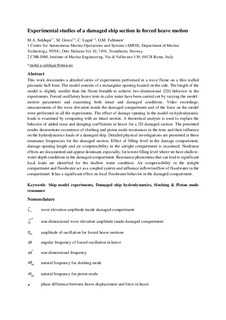| dc.contributor.author | Siddiqui, Mohd Atif | |
| dc.contributor.author | Greco, Marilena | |
| dc.contributor.author | Lugni, Claudio | |
| dc.contributor.author | Faltinsen, Odd Magnus | |
| dc.date.accessioned | 2019-06-13T09:09:11Z | |
| dc.date.available | 2019-06-13T09:09:11Z | |
| dc.date.created | 2019-05-28T16:42:13Z | |
| dc.date.issued | 2019 | |
| dc.identifier.citation | Applied Ocean Research. 2019, 88 254-274. | nb_NO |
| dc.identifier.issn | 0141-1187 | |
| dc.identifier.uri | http://hdl.handle.net/11250/2600703 | |
| dc.description.abstract | This work documents a detailed series of experiments performed in a wave flume on a thin walled prismatic hull form. The model consists of a rectangular opening located on the side. The length of the model is slightly smaller than the flume breadth to achieve two-dimensional (2D) behavior in the experiments. Forced oscillatory heave tests in calm water have been carried out by varying the model-motion parameters and examining both intact and damaged conditions. Video recordings, measurements of the wave elevation inside the damaged compartment and of the force on the model were performed in all the experiments. The effect of damage opening in the model on hydrodynamic loads is examined by comparing with an intact section. A theoretical analysis is used to explain the behavior of added mass and damping coefficients in heave for a 2D damaged section. The presented results demonstrate occurrence of sloshing and piston mode resonances in the tests and their influence on the hydrodynamics loads of a damaged ship. Detailed physical investigations are presented at these resonance frequencies for the damaged section. Effect of filling level in the damage compartment, damage-opening length and air compressibility in the airtight compartment is examined. Nonlinear effects are documented and appear dominant, especially, for lowest filling level where we have shallow-water depth conditions in the damaged compartment. Resonance phenomena that can lead to significant local loads are identified for the shallow water condition. Air compressibility in the airtight compartment and floodwater act as a coupled system and influence inflow/outflow of floodwater in the compartment. It has a significant effect on local floodwater behavior in the damaged compartment. | nb_NO |
| dc.language.iso | eng | nb_NO |
| dc.publisher | Elsevier | nb_NO |
| dc.rights | Attribution-NonCommercial-NoDerivatives 4.0 Internasjonal | * |
| dc.rights.uri | http://creativecommons.org/licenses/by-nc-nd/4.0/deed.no | * |
| dc.title | Experimental studies of a damaged ship section in forced heave motion | nb_NO |
| dc.type | Journal article | nb_NO |
| dc.type | Peer reviewed | nb_NO |
| dc.description.version | acceptedVersion | nb_NO |
| dc.source.pagenumber | 254-274 | nb_NO |
| dc.source.volume | 88 | nb_NO |
| dc.source.journal | Applied Ocean Research | nb_NO |
| dc.identifier.doi | 10.1016/j.apor.2019.04.010 | |
| dc.identifier.cristin | 1701012 | |
| dc.description.localcode | © 2019. This is the authors’ accepted and refereed manuscript to the article. Locked until 9 May 2021 due to copyright restrictions. This manuscript version is made available under the CC-BY-NC-ND 4.0 license http://creativecommons.org/licenses/by-nc-nd/4.0/ | nb_NO |
| cristin.unitcode | 194,64,20,0 | |
| cristin.unitname | Institutt for marin teknikk | |
| cristin.ispublished | false | |
| cristin.fulltext | postprint | |
| cristin.qualitycode | 1 | |

